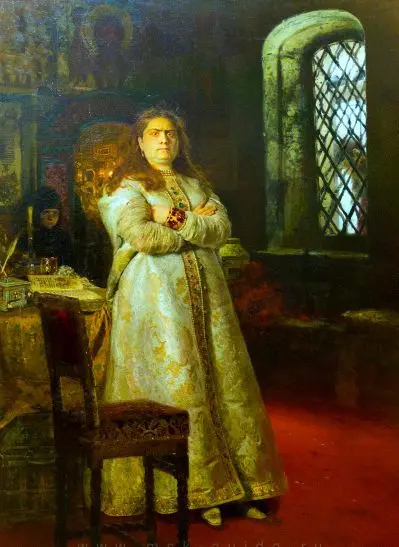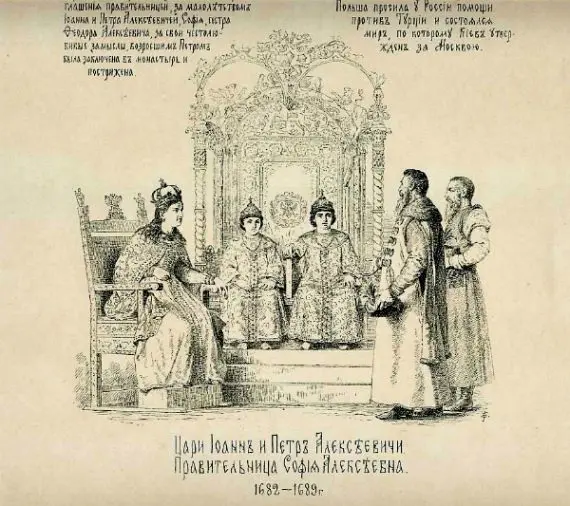Contents
😉 Greetings, history lovers! Thank you for choosing the article “Biography of Princess Sophia Alekseevna” on this site!
Sofya Alekseevna Romanova
Tsarevna Sophia, according to school history books, Russians are used to associating with a terrible rifle revolt. There is also a portrait of her, where she is depicted as an overweight and vicious woman, whose age is about fifty years, no less.

“Princess Sophia Alekseevna a year after her imprisonment in the Novodevichy Convent”, artist Ilya Repin
But it was she who was the first enlightened ruler of the Russian state, although she was called the regent under the young princes: Ivan and Peter.
Peter I often pictured himself as the first tsar who turned the country away from the Asiaticism of Byzantium and the Golden Horde and “cut a window” to progressive Europe. But the tsar was a little cunning, often attributing to himself the merits of his father and the hated “sister” Sofyushka.
Alexey Mikhailovich Romanov (1629-1676)
Children of Alexei Mikhailovich:
- From marriage with Maria Ilyinichna Miloslavskaya – 13 children;
- From marriage with Natalia Kirillovna Naryshkina – 3 children.
Sovereign Alexei Mikhailovich was interested in Europe and, although he did not dream of carrying out a full-scale U-turn in the country and “Europeanizing” Russia, he adopted a lot. The boyars in the Duma were shocked when the tsar personally read the news from European countries, which were translated by special interpreters.
The boyars were outraged not by the news from some countries, many of them did not even imagine whether they were far or close, but what the clerks were supposed to read according to tradition. However, Alexey Mikhailovich did not trust them. They read so monotonously that almost everyone, listening to them, quickly fell asleep.
In order for European newspapers to be delivered to the Kremlin, a regular postal line was established connected with Western countries. The sovereign simplified the ceremony of signing documents, getting acquainted with the content and signing them personally.
By his order, the rooms were covered with imported wallpaper. The furniture was replaced by the fashionable at the time in the Baroque style. A telescope was ordered in Denmark, and a carriage in Germany.
The boyars grumbled among themselves, but when the Kremlin had its own theater, the church could not stand it. She has long equated hypocrisy with devilry, but here the “anointed of God” himself arranged a theater for his children …
Fedor III Alekseevich (1661-1682)
The children of Alexei Mikhailovich were interested in news from Europe. Sophia composed plays, they were then played in her chambers. Fyodor, who reigned for 6 years, married Agafya Grushetskaya, a Polish woman. She, having consulted with her husband, introduced Polish fashion not only for clothes, but also for hairstyles.
Marrying a polka caused a serious scandal. The Rurikovichs married foreign princesses, the Romanovs never before.
Princess Sophia Alekseevna (1657-1704)
Peter looked like a Westerner only in comparison with Sophia, who was interested in the situation and trends in European countries. She, not wanting to tease the boyars, diligently followed the traditions – she did not leave the maiden’s mansion, she gave only Russian outfits.
Previously, princesses were not taught. Their lot was a monastery. A marriage with a boyar or a prince meant the loss of the tsar’s dignity. Marrying a non-Orthodox prince was absolutely unacceptable.
When the princess was 25 years old, she was tonsured a nun. From now on, her duty was to bow at the icons, praying for the health and well-being of her relatives.
Sophia studied like foreign princesses. When the king noticed how inquisitive the daughter was, a teacher was hired for her. The young princess studied literacy, foreign languages, history, natural science …
Unfortunately, there was no need to even think about marriage. Besides, she was ugly. But she did not despair, but took up politics. Even under Tsar Fedor, with the help of skillful intrigues, she quite often sought to reduce his authority, at the same time strengthening her own.
She told the boyars that Agafya was asleep and saw the conversion of the king to the Catholic faith. He does not adhere to Russian customs and traditions. Although Sophia followed these customs only in dress and overly ostentatious piety.
When Tsar Fyodor died, a difficult situation arose in Russia with the succession to the throne. According to the law, his 16-year-old brother Ivan was to ascend the throne. But Ivan often showed strong and long-term seizures of epilepsy, and the boyars considered him insane. In addition, he was not interested in politics, and he did not seek to take the throne.
Sofya Alekseevna Romanova: domestic and foreign policy
The Dowager Queen Natalya Kirillovna declared her 10-year-old son Peter to be heir to the throne. The state has split into two irreconcilable camps. Some were for Ivan, others, realizing that the tsar would be painful, advocated for Peter.
Therefore, although they associate the streltsy revolt with Sofya Alekseevna, it was in favor of her mother’s family. The confrontation between the Miloslavsky and Naryshkin clans threatened to turn into a real war between the clans. But here the church said its word. She forced both sides to agree to the co-rule of Ivan and Peter, appointing Sophia as regent.

Such a regency was for the first time for the Romanov dynasty. The textbooks say that Sophia craved power. But she felt her strength and real talent for government. During her regency, she underwent several successful progressive reforms. On her instructions, the first academy in Russia was created.
The thieves were not executed, and in the event of a relapse, their hand was cut off. Women who could not withstand years of abuse from their husbands and who killed their tormentors were no longer sentenced to death by burying them in the ground up to their waist. Now they were executed.
The regent managed to conclude a profitable peace with Poland. She sent ambassadors to France to persuade the authorities to abandon the alliance with Turkey.
If not for Peter, Sophia could have become the empress on a par with Elizabeth and Catherine. But Peter became king, and history, as you know, is composed by the victors.
The regent was deposed and sent to the monastery. She went down in history as a fat and ugly woman who rebelled against a progressive king, because she wanted to rule in the old fashioned way.
😉 Friends, leave additions on the topic “Biography of Princess Sophia Alekseevna”. Share information on social media networks. Subscribe to the newsletter of new articles to your e-mail. mail. Fill out the form above: name and e-mail.









